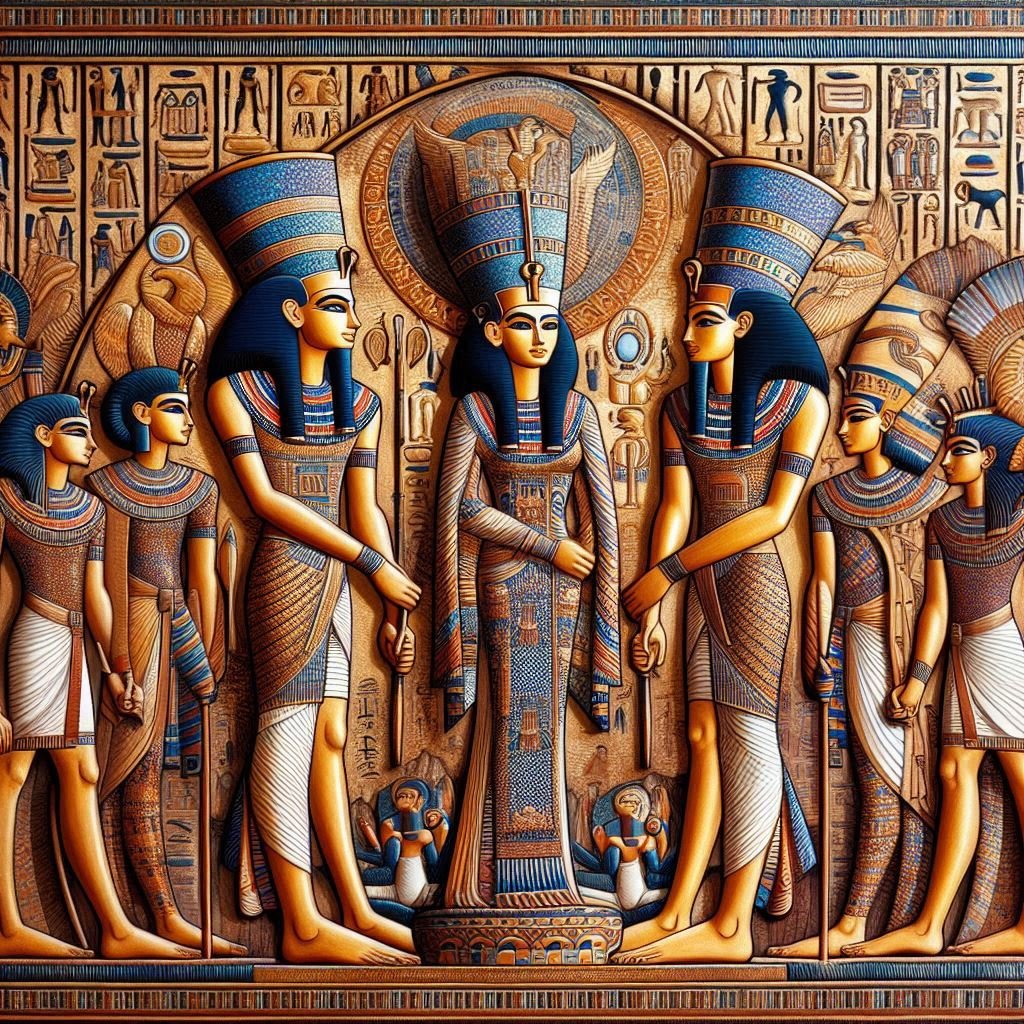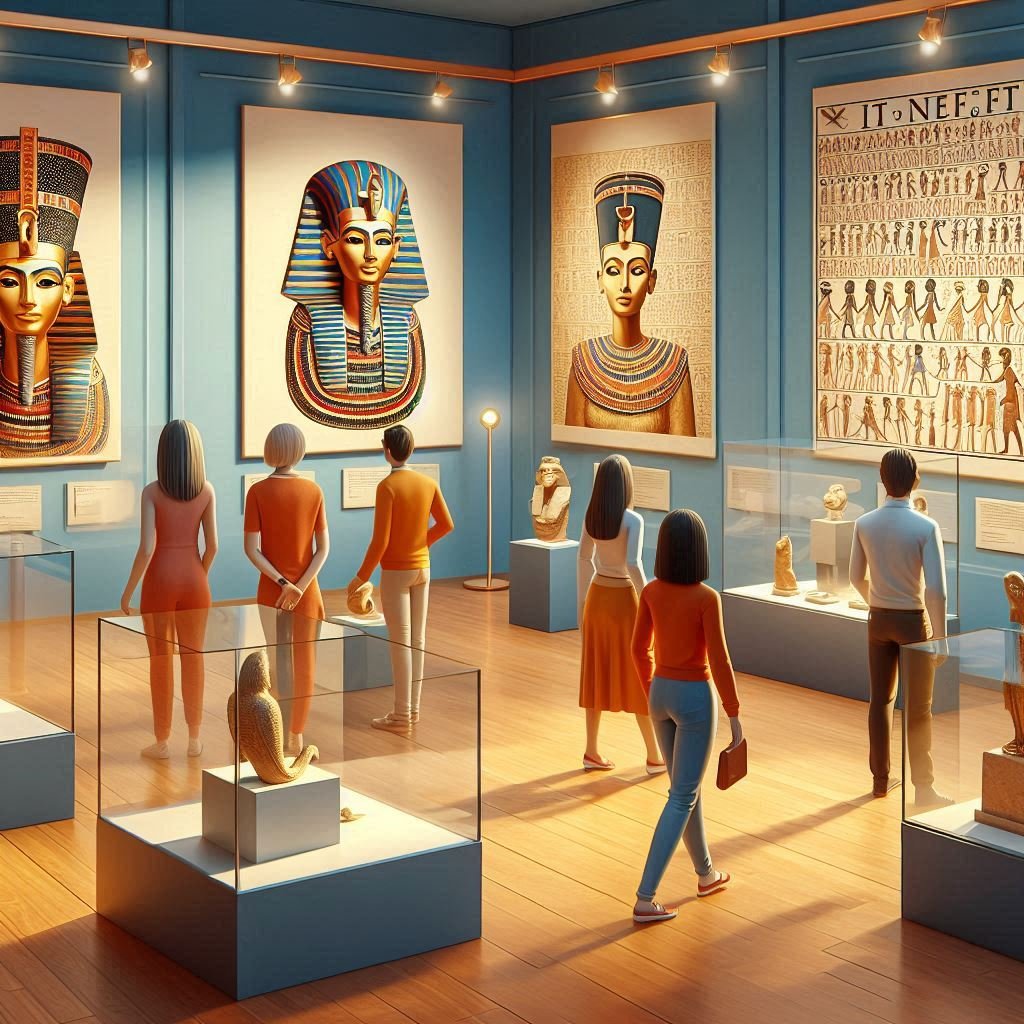Queens of Ancient Egypt (Nefertiti, Cleopatra)
The tales of the Queens of Ancient Egypt (Nefertiti, Cleopatra) have fascinated historians, scholars, and enthusiasts for centuries. These two iconic figures stand out not only for their beauty and power but also for their significant contributions to Egyptian history and culture. As we delve into the lives of Nefertiti and Cleopatra in 2024, we continue to be mesmerized by their stories of ambition, intrigue, and resilience.
Nefertiti: The Enigmatic Beauty
Nefertiti, whose name means “The Beautiful One Has Come,” was the Great Royal Wife of Pharaoh Akhenaten during the 18th Dynasty. Her life and legacy are integral to understanding the broader narrative of the Queens of Ancient Egypt (Nefertiti, Cleopatra).

Early Life and Marriage
Nefertiti’s origins remain a subject of debate among scholars. Some theories suggest she was of royal birth, possibly the daughter of a high-ranking official, while others speculate she may have been a foreign princess. Her marriage to Akhenaten marked the beginning of one of ancient Egypt’s most transformative periods. Together, they initiated a religious revolution, shifting the worship from the traditional pantheon of gods to the worship of Aten, the sun disk.
The Amarna Period
Nefertiti played a crucial role during the Amarna Period, a time of significant religious and cultural upheaval. She is often depicted alongside Akhenaten in art, participating in religious ceremonies and state functions, highlighting her influence and status. This partnership between the pharaoh and queen was unprecedented, marking Nefertiti as a powerful and influential figure among the Queens of Ancient Egypt (Nefertiti, Cleopatra).
The art from this period, characterized by its distinctive style, often portrays Nefertiti with grace and elegance. The famous bust of Nefertiti, discovered in 1912, remains one of the most iconic symbols of ancient Egyptian beauty and artistry. This artifact has immortalized her as a timeless symbol of elegance and power.
Mysterious Disappearance
Nefertiti’s later life remains shrouded in mystery. Some theories suggest she may have ruled as a co-regent alongside Akhenaten or even succeeded him under a different name. Her disappearance from historical records around the 12th year of Akhenaten’s reign has fueled much speculation. Despite this mystery, her legacy as one of the Queens of Ancient Egypt (Nefertiti, Cleopatra) endures, captivating the imagination of generations.
Cleopatra: The Last Pharaoh
Cleopatra VII, the last active ruler of the Ptolemaic Kingdom of Egypt, is another iconic figure among the Queens of Ancient Egypt (Nefertiti, Cleopatra). Her life was marked by political acumen, romantic liaisons, and a tragic end, making her one of history’s most compelling figures.
Early Life and Ascension
Cleopatra was born into the Macedonian Greek dynasty that ruled Egypt after Alexander the Great’s conquests. Educated and multilingual, she was well-prepared to navigate the complex political landscape of her time. Cleopatra ascended to the throne at the age of 18, initially co-ruling with her younger brother Ptolemy XIII.

Political Alliances and Romance
Cleopatra’s reign was marked by her strategic political alliances, most notably with Julius Caesar and Mark Antony. These alliances were as much about love as they were about securing her position and Egypt’s independence. Her relationship with Caesar not only solidified her power but also produced a son, Caesarion, who was named co-ruler.
After Caesar’s assassination, Cleopatra aligned with Mark Antony. Their union produced three children and strengthened her political influence. However, this alliance also set the stage for conflict with Rome, particularly with Octavian (the future Augustus Caesar).
The Battle of Actium and Tragic End
The fateful Battle of Actium in 31 BCE marked the beginning of the end for Cleopatra. Defeated by Octavian’s forces, she and Antony retreated to Egypt. Facing inevitable defeat, Cleopatra chose to end her life, reportedly by the bite of an asp. This dramatic end cemented her legacy as a tragic heroine and a formidable player in the political arena.
Legacy and Cultural Impact
The legacies of the Queens of Ancient Egypt (Nefertiti, Cleopatra) continue to resonate in contemporary culture. Nefertiti and Cleopatra are celebrated not only for their political and cultural contributions but also for their enduring influence on art, literature, and popular culture.
Nefertiti’s Enduring Symbolism
Nefertiti remains an emblem of beauty and power. Her bust is one of the most replicated and admired artifacts, symbolizing the artistic achievements of ancient Egypt. Her role in the religious revolution alongside Akhenaten highlights her as a pivotal figure in Egyptian history.

Cleopatra’s Cinematic and Literary Presence
Cleopatra’s life has inspired countless works of art, literature, and film. From Shakespeare’s “Antony and Cleopatra” to the iconic portrayals by Elizabeth Taylor in the 1963 film, her story has been told and retold, each time highlighting her intelligence, charm, and tragic end. Cleopatra’s image as the quintessential queen of seduction and power remains a powerful symbol in modern culture.
Conclusion
The Queens of Ancient Egypt (Nefertiti, Cleopatra) embody the grandeur, intrigue, and resilience of ancient Egyptian civilization. Nefertiti’s enigmatic beauty and pivotal role in the Amarna Period, coupled with Cleopatra’s political savvy and tragic romance, create a rich tapestry of history that continues to captivate us in 2024.
As we reflect on the lives of these remarkable women, we are reminded of their significant contributions to the cultural and political landscapes of their time. The Queens of Ancient Egypt (Nefertiti, Cleopatra) not only shaped the course of history but also left an indelible mark on the world’s cultural heritage. Their stories of ambition, power, and resilience continue to inspire and fascinate, ensuring their legacies endure for generations to come.